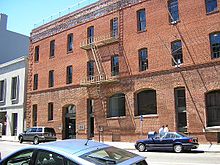Linden Lab
| Linden Research, Inc.
|
|
|---|---|
| legal form | Holding company |
| founding | 1999 |
| Seat | San Francisco , United States |
| management | Ebbe Altberg ( CEO ) |
| Number of employees | 350 (Q1 2010) |
| Branch | Computer, software |
| Website | www.lindenlab.com |
Linden Lab is an American company from San Francisco , California and operator of the 3D world simulation Second Life .
Linden Lab was founded in 1999 by Philip Rosedale , former CTO of Real Networks . The company is based on the company's premier address, Linden Alley in Hayes Valley. Rosedale had already developed video compression software (FreeVue) in 1995, was involved in the development of RealVideo and, since his contact with the Internet in the mid-1990s, had sought to create the virtual simulation of a world in which the participants could participate in any three-dimensional environment they could design Freely configurable avatars in realtime animation ( realtime 3D streaming ) can interact freely. From his own resources he invested around 1 million US dollars in a corresponding project by 2001.
The most important result of the development work was the 3D world simulation Second Life , the public beta test of which began in October 2002 and which has been online since June 2003. In April 2003, Mitch Kapor became a partner and chairman of the company's board of directors. Since initially there was no commercial success through the pure financing through paid memberships, no further investors were found. At the end of 2003, the workforce shrank from 31 to 20.
At the end of 2003 trading activities in Second Life were integrated into the regular economic cycle via the convertibility of the virtual currency Linden dollar to the US dollar. Linden dollars can thus be bought and sold at a relatively fixed exchange rate. The emerging sales within this miniature economy aroused the interest of investors, including since 2004 the Omidyar Network , the company of Ebay founder Pierre Omidyar and, since another capital increase in 2006, the CEO of Amazon.com , Jeff Bezos .
Since then, Linden Lab has financed itself through paid premium memberships for Second Life users, through commissions for exchanging virtual currency and in particular (in January 2007 allegedly 70%) through the sale of virtual properties within Second Life on which the members be able to construct your own objects (buildings, interiors, environments). In addition, there is a monthly rent that the "property owners" have to pay. The “gross national product” of this miniature virtual economy was around 10 million US dollars per month at the beginning of 2007. The growth in sales and membership within the virtual world operated by Linden Lab was estimated at around 20% per month at the time.
According to USA Today on February 5, 2007, Linden Lab has approximately 140 employees, 28 of whom are engineers.
The company has now placed the Second Life client software under an open source license. In January 2007 Linden Lab also announced that it wanted to fundamentally change its most important sales segment (selling virtual land in Second Life).
In September 2012 Linden Lab introduced two new products: Creatorverse (for iPad ) and Patterns ( desktop application ).
In July 2013 Linden Lab acquired the digital game distribution platform Desura .
In July 2014 Linden Lab officially announced that the company was working on a successor to the free virtual world "Second Life". Reasons were not given, but Second Life has many technical problems and limitations that should be eliminated by completely redeveloping the entire software architecture (e.g. missing mobile or browser version, maximum 100 avatars per simulator, incorrect avatar display, outdated user-generated content with long loading times, compatibility problems of software and content, latency problems, grief problems, etc.). In the course of the new development, Linden Lab has announced that it will hire 50 new developers in the USA from July 2014, and withdraw the majority of the existing engineers from the development of Second Life and take them over to the team for the 'new' virtual world.
The title is currently called Project Sansar , and interested parties can apply for the closed beta test ( "Creator Preview" ). This and the current Second Life should exist in parallel for an indefinite period of time. The plan to develop this new virtual world is said to have been decided in 2012 by the then CEO Rod Humble.
Project Sansar is not supposed to be an upgrade from the existing Second Life, but a completely new development, and the compatibility of the existing content with the new 3D world is not the focus of the developers for the time being. Linden Lab writes that this new development is being developed "in the spirit of Second Life", with the possibility of buying and selling virtual land and goods, with individually designed avatars, a scripting language, chat and the possibility for users to use this 3D- To design and model the world yourself.
It is also at least envisaged that the friend lists and avatar names of existing users should be transferred to the new version. Linden Lab has emphasized several times that this does not mean the end of the well-known Second Life.
Web links
Individual evidence
- ↑ http://www.inc.com/magazine/20070201/hidi-rosedale.html
- ↑ http://www.lindenlab.com/releases/coming-soon-from-linden-lab-creatorverse-and-patterns
- ↑ http://lindenlab.com/releases/linden-lab-acquires-desura
- ^ Project Sansar: New VR world from the Second Life makers - Golem.de. In: www.golem.de. Retrieved May 9, 2016 .
- ^ Apply for the Project Sansar Creator Preview. Linden Lab, May 9, 2016, accessed May 9, 2016 .
- ↑ http://lindenlab.com/releases/linden-lab-is-developing-the-next-generation-virtual-world
